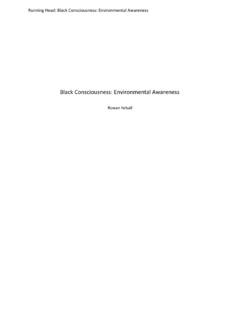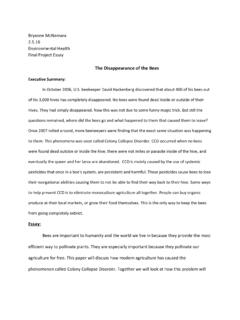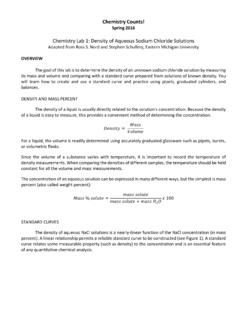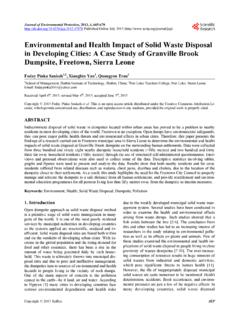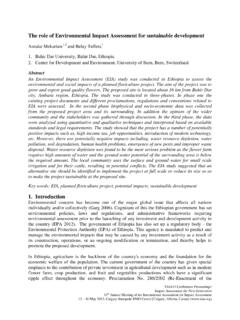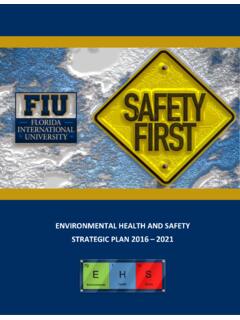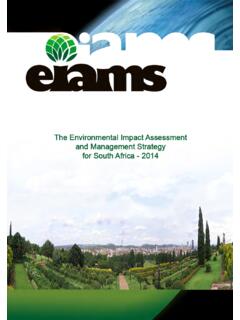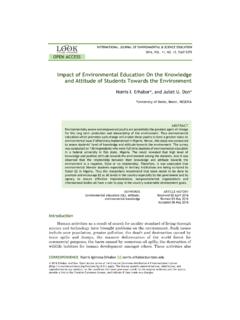Transcription of Socio-economic and Environmental Impact of …
1 C j | Environmental health and Social Justice | March 3, 2016 Socio-economic and Environmental Impact of homelessness in Olympia, Washington BY: CHRISTOPHER JOHNSON PAGE 1 Executive Summary All over the world people go without shelter, food and the basic necessities to live a full, promising life. Often looked down on as the dredges of society, but yet, the homeless population continues to grow. There are many effects of homelessness on our society and on our environment. The goal of this paper is to outline the socioeconomic aspects and Environmental damage that is caused by people who are ignored by society. More specifically, I will highlight Olympia, Washington and its current issue of homelessness in order to analyze how the environment, economy and health and safety concerns are affected by homelessness .
2 With this information, my hope is to bring more light to this issue and call on the powers that be for solutions. Introduction In the midst of the lush beauty of the Pacific Northwest, Olympia Washington serves as an example of natural beauty and as the capitol of Washington state. Over time, the area has been home to those without. However, and sadly, there is a cause and effect for everything. With that said, there is evidence of the area being degraded on a Socio-economic and Environmental level by an increasing homeless population. The extrospective will attempt to identify the effects of the homeless population in Olympia Washington. This will be done by examining the Environmental and socio-PAGE 2 economic relationships with homelessness , to include, human health concerns, Environmental destruction and societal costs.
3 homelessness is not a problem that has developed overnight. Each year more and more people move to the streets as a result of extreme poverty. There are many reasons why a person can become homeless. Finding that reason is simple, the difficulty lies within the causality of creating communities within another community, encampments. Those afflicted by homelessness are usually not aware of the Environmental and economic destruction that reflects their survival. However, those living in surrounding areas have seen the change. As unfortunate as this subject is, a need to examine the ways harm is being done to everyone sharing this landscape is warranted. Socio-economics General According to the Thurston County homeless census for 2015, 476 members of this community were documented as homeless, however the number is estimated closer to 700 with a sect of the population not being reported properly.
4 This number does not seem staggering, however, Olympia is a small city in comparison to the likes of New York, Los Angeles, Chicago, etc. 2015 was an important, landmark year for the city of Olympia, as a ten-year plan was created in 2005 in order to best serve these individuals and eliminate homelessness for good (in the local area). According to the PAGE 3 data harvested from Thurston County, of the 476 individuals that are homeless, only a third of them have consistent shelter. Which leads to the two thirds of the rest of the population seeking shelter by any means necessary. Furthermore, the program lacks a record of success. In 2005 the homeless population was 441 which is only slightly smaller than the 2015 reported numbers. In 2010, that number spiked to 976, being the largest population within the ten-year program.
5 To be fair to the census, it is only as good as the number of people that are reporting. Due to the highly wooded areas, it is safe to assume a larger population exists outside of highway on/off ramps, alleyways, overpasses and shelters. Often, a shelter is wherever a person can find suitable defense from the weather and personal safety within the public sector. Again, this has a cause and effect. PAGE 4 According to the 2015 cost benefit analysis done by the same Thurston county program that collected census data, the annual cost of homelessness to the city and state comes to $129,728, (Please note that services such as medical care and law enforcement encompass budgets for the entire community). Most of the costs come from providing adequate medical care, shelters and incarcerating homeless people. Note that the numbers are raw but provide a brief overview of how much money is allocated to helping serve the needs of the public.
6 To demonstrate, the city of Olympia as recent as 2015 began increasing police patrols, requiring more officers and a larger patrol canvas. A need for more funding was appropriate but would be wholly unnecessary if the problem could be solved (best case scenario) or at least if the city could see a dramatic decrease in the overall homeless population. Of the $130 Mil allocated, most of the money is used to house inmates and staffing safe places or shelters. However, the majority of the money is from immediately life threatening physical and mental medical conditions. These types of conditions are on the upswing because of the unpredictable weather patterns within the Pacific Northwest, often attributed to climate change. In King county Seattle, a spike in seasonal medical conditions has spiked. The climate is no longer moderately temperate and has shown high heat in the summer months and even extreme cold in the winters (National health Care for the Homeless Council,2016).
7 Social programs throughout the city are not entirely non-profit organizations. Granted there are quite a few non-profits trying to assist in the problem, there are still PAGE 5 levels of state and legislative involvement. An increase in the Washington Work Source program has been revamped to provide more job training services to those who are in need. The Work Source service offers free services not only for the aforementioned job training, but also offer free access to office amenities, crucial to finding employment. This is program also pays out unemployment insurance for the state (Worksource, 2016). *see attached graphs provided by Thurston County Commercial and Residential Unfortunately, there is a social stigma revolving around homelessness . Again, aesthetics come in to play, the sight of used drug paraphernalia, unwashed and unkempt individuals often create a picture that most are too ashamed to look at.
8 The appearance creates a litany of warning signs to the potential customers of businesses in the Olympia downtown areas and even more often, a perception of crime based on fear and poorly discarded drug paraphernalia. Often, this sight can push away potential customers locally, and more importantly investors looking to create a new market for those potential customers. Potential investors and land owners are also now operating at a loss from ownership of these areas, as property values have lowered due to the sight of homeless individuals and the improvised shelters relatively close to the commercial and residential zones. These shelters are necessary for the individual homeless but act as a deterrent to most investors and customers alike. PAGE 6 Consequentially the homeless population can lower local business revenue, due to general fear and disgust that has become a mainstay attitude of the affluent.
9 This notion is based on general economic and social cues. People will not populate areas they deem unsafe, thus less foot traffic in local stores and businesses and less interest in residential property. Homes in this area are no longer coveted, as people do not want to live in an area where a large portion of the population is impoverished. Homes and land lose value and cause an economic downswing in the market. Often, pushing people, ironically, to homelessness , an end to this cycle needs to manifest itself. Tourism As mentioned, tourism is also affected by homelessness . People are less inclined to tour an area that seems rundown due to a fear of an increased crime rate and large drug use population. People are also less likely to visit due to higher crime rates (often associated with homeless, which also attributes to larger budgetary needs to fund law enforcement and clean up crews) and the potential to be hassled for money.
10 Most of us can only sympathize so much before we just avoid the area all together, thus creating a potential to scare away new and old business. This directly correlates to a decline in profits from local businesses and because of all these factors, contributes to declining land values. PAGE 7 Environmental Encampments, Litter, Run-off, Disease and Drug Waste With ease of access and availability, public areas have become havens for those who cannot find appropriate shelter. Encampments or communal shelters have become a massive threat to the environment. Not only to the Earth but also to those living the areas. Litter is a commonality found anywhere you look. Highways, streets, parks, etc. are used as garbage cans for the homeless and those with homes. However, homeless waste is usually left within the area for much longer, as encampments are usually long PAGE 8 standing structures near waterways and of course parks.
